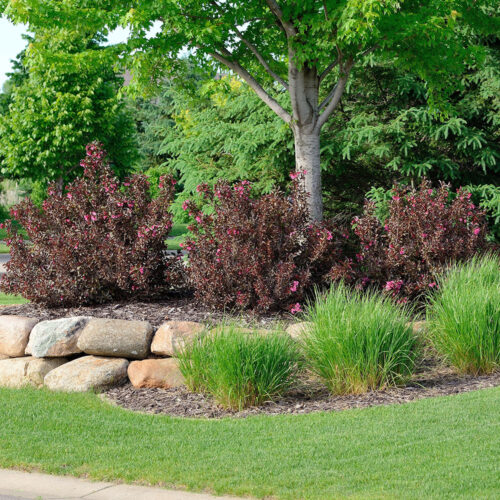Installing features on a landscape is time consuming, so you want to make sure you get things right the first time. Replacements and return work can be expensive, damage your business’s reputation, and require a lot of extra labor and time to fix. You’ll want to have a backup plan in place to protect your new instillations from the most common errors or oversights that can occur.
Improper watering practices – both under and over watering – is one of the biggest challenges to keeping new plants healthy. By managing soil moisture, Hydretain provides numerous benefits to improve plant survival. Once applied and watered into the root zone, Hydretain functions to condense soil moisture back into plant usable water droplets. For underwatering issues, in environments with drought, or in places with watering restrictions, use Hydretain to increase watering efficiency and allow plants to thrive twice as long between watering cycles. Hydretain won’t swell up and store water, affect saturated soils during periods of excess rainfall, or lead to root rot or increased fungus growth. For over-waterers, use Hydretain to provide the comfort they need to cut back to healthy watering frequencies.
Here are some ways you can incorporate Hydretain into your landscaping and planting practices:
Flowers/Color Installation
By increasing water availability to plant roots, Hydretain improves transplant establishment, minimizes wilt and extends flowers life.
- Drench: Add liquid Hydretain at a rate of 2 oz. per gallon of water to the initial drench solution used to water in transplants.
- Pre-Plant Dip: Dilute Hydretain at a rate of 2 oz. per gallon of water and use as a pre-soak dip to treat trays or potted plants prior to transplant. Allow plants to sit in dip solution long enough to saturate the soil media.
- Spray: Dilute Hydretain at a rate of 2 oz. per gallon of water and apply 1 gallon of solution per 60 sq. ft. of area (one gallon of Hydretain treats 4,000 sq. ft. of landscape beds). Rinse Hydretain solution off of flowers and water-in to the root zone.
- Incorporate: Add Hydretain Granular OC or QD into the bed before planting at a rate of 1 lb. per 100 square feet of planter bed.
- Spread: Apply Hydretain Granular OC or QD topically around plants after installation at rate of 1 lb. per 100 square feet of planter bed.
Turfgrass
From winter damage repair to new lawn installation, Hydretain increases seed germination and improves the survival of seedlings, sod, springs and plugs.
- Spread: Apply Hydretain Granular OC or QD at rate of 2.7 lbs. per 1,000 sq. ft. Add Hydretain Granular products to the soil prior to planting or spread it over the top of new seed, sod, springs or plugs.
- Spray: Apply liquid Hydretain at a rate of 9 oz per 1,000 sq. ft. Spray Hydretain liquid products on the soil immediately prior to planting or over the top of new seed, sod, springs, or plugs and water-in to the seed level or root zone.

Trees and Shrubs:
When installing new trees and shrubs, use Hydretain to reduce transplant shock and improve survival rate for these larger landscape assets.
- Incorporate: Add Hydretain granular throughout the backfill soil when planting new trees and shrubs at a rate of 1 lb. per cubic foot of planting media for shrubs and 1.2 to 2 lbs. per caliper inch for trees.
- Drench: Dilute Hydretain at a rate of 2 oz per gallon of water and saturate the root ball prior to planting or use diluted material as a post installation drench solution. For trees, apply Hydretain at a rate of 4 oz per caliper inch.
- Injection into Drip Irrigation: Apply at a rate of 4 oz of Hydretain concentrate per caliper inch.
- Watering Bags: When using watering bags, Hydretain can be added directly into the bag at a rate of 4 oz per caliper inch.
Keep all these different application methods for Hydretain in mind when preparing landscapes. Plan ahead to consider what you’ll need Hydretain for and how it should be best applied!

